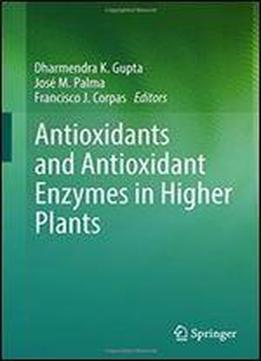
Antioxidants And Antioxidant Enzymes In Higher Plants
by Dharmendra K. Gupta /
2018 / English / PDF
5.1 MB Download
This book provides an overview of antioxidants and antioxidant enzymes and their role in the mechanisms of signaling and cellular tolerance under stress in plant systems.
Major reactive oxygen species (ROS)-scavenging/modulating enzymes include the superoxide dismutase (SOD) that dismutates O2 into H2O2, which is followed by the coordinated action of a set of enzymes including catalase (CAT), ascorbate peroxidase (APX), glutathione peroxidase (GPX) and peroxiredoxins (Prx) that remove H2O2. In addition to the ROS scavenging enzymes, a number of other enzymes are found in various subcellular compartments, which are involved in maintaining such redox homeostasis either by directly scavenging particular ROS and ROS-byproducts or by replenishing antioxidants. In that respect, these enzymes can be also considered antioxidants. Such enzymes include monodehydroascorbate reductase (MDAR), dehydroascorbate reductase (DHAR), glutathione reductase (GR), alternative oxidases (AOXs), peroxidases (PODs) and glutathione S-transferases (GSTs). Some non-enzymatic antioxidants, such as ascorbic acid (vitamin C), carotenes (provitamin A), tocopherols (vitamin E), and glutathione (GSH), work in concert with antioxidant enzymes to sustain an intracellular steady-state level of ROS that promotes plant growth, development, cell cycles and hormone signaling, and reinforces the responses to abiotic and biotic environmental stressors.
Offering a unique compilation of information on antioxidants and antioxidant enzymes, this is a valuable resource for advanced students and researchers working on plant biochemistry, physiology, biotechnology, and signaling in cell organelles, and those specializing in plant enzyme technologyThis book provides an overview of antioxidants and antioxidant enzymes and their role in the mechanisms of signaling and cellular tolerance under stress in plant systems.
Major reactive oxygen species (ROS)-scavenging/modulating enzymes include the superoxide dismutase (SOD) that dismutates O2 into H2O2, which is followed by the coordinated action of a set of enzymes including catalase (CAT), ascorbate peroxidase (APX), glutathione peroxidase (GPX) and peroxiredoxins (Prx) that remove H2O2. In addition to the ROS scavenging enzymes, a number of other enzymes are found in various subcellular compartments, which are involved in maintaining such redox homeostasis either by directly scavenging particular ROS and ROS-byproducts or by replenishing antioxidants. In that respect, these enzymes can be also considered antioxidants. Such enzymes include monodehydroascorbate reductase (MDAR), dehydroascorbate reductase (DHAR), glutathione reductase (GR), alternative oxidases (AOXs), peroxidases (PODs) and glutathione S-transferases (GSTs). Some non-enzymatic antioxidants, such as ascorbic acid (vitamin C), carotenes (provitamin A), tocopherols (vitamin E), and glutathione (GSH), work in concert with antioxidant enzymes to sustain an intracellular steady-state level of ROS that promotes plant growth, development, cell cycles and hormone signaling, and reinforces the responses to abiotic and biotic environmental stressors.











